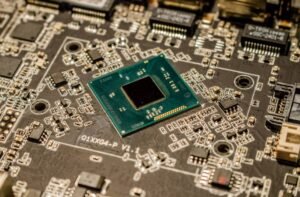AI Video Interpolation
Artificial Intelligence (AI) has continued to significantly impact various industries, and one area where it is cutting-edge is in video interpolation. AI video interpolation techniques allow for the creation of smooth, high-quality slow-motion videos from regular ones, resulting in visually appealing and captivating content.
Key Takeaways:
- AI video interpolation improves the quality of slow-motion videos using advanced algorithms.
- By generating intermediate frames, AI fills the gaps between original frames, creating seamless and lifelike slow-motion footage.
- The process involves training AI models on large databases of pre-existing footage to learn the patterns and movements of objects in videos.
- AI video interpolation has several applications, including sports analysis, special effects in movies, and enhancing the viewing experience for video content.
AI video interpolation utilizes deep learning algorithms to analyze existing frames of a video and generate additional frames between them, effectively increasing the frame rate. This interpolation process results in videos with smoother slow-motion effects and reduced jerkiness. *For example, a regular video recorded at 30 frames per second (fps) can be transformed into slow-motion footage with a frame rate of 240 fps or higher, providing incredible detail and fluidity.*
How Does AI Video Interpolation Work?
AI video interpolation leverages neural networks, specifically convolutional neural networks (CNNs), to learn patterns and movements from a vast amount of existing video footage. These networks are trained using deep learning techniques to generate intermediate frames that seamlessly fit between the original frames of a video. *Through this training process, the AI model learns to predict what the missing frames should look like based on the surrounding frames, resulting in smooth and realistic slow-motion videos.*
As the AI model analyzes and understands the motion in a video, it can accurately predict how the objects in the scene would move and behave between each frame. It fills in the missing frames with visually consistent content, creating the illusion of slow motion. This interpolation process adds smoothness and detail to the video, enhancing the viewing experience. *With AI video interpolation, even low frame rate videos can be transformed into visually stunning slow-motion footage.*
Applications of AI Video Interpolation
The applications of AI video interpolation are diverse and span across various industries. A few notable use cases include:
- Sports analysis: AI video interpolation enables sports analysts to study movements and techniques in greater detail by providing enhanced slow-motion replays. This can aid in improving player performance and understanding game dynamics.
- Special effects in movies: By creating seamless slow-motion shots, AI video interpolation contributes to the production of visually captivating special effects in movies.
- Enhancing user experience: Online video platforms and streaming services can use AI video interpolation algorithms to enhance the visual quality of their content, providing viewers with a more immersive experience.
The Future of AI Video Interpolation
The development of AI video interpolation is an ongoing process, with researchers continuously working on improving the quality and efficiency of the algorithms. Efforts are being made to reduce artifacts and refine the interpolation results further. Additionally, advancements in hardware acceleration are aiding in real-time video interpolation implementations, making the technology more accessible *even for applications that require immediate processing, such as live broadcasts or real-time video streaming.*
| Pros | Cons |
|---|---|
| Creates smooth and high-quality slow-motion videos. | May introduce visual artifacts in certain cases. |
| Enhances the viewing experience for video content. | Requires significant computational resources. |
| Improves sports analysis and special effects in movies. | May not be suitable for all types of videos (e.g., rapidly changing scenes). |
| Opens up possibilities for real-time video interpolation. | Training AI models requires extensive datasets. |
In conclusion, AI video interpolation is revolutionizing the world of slow-motion videos by providing smooth, lifelike visuals. Utilizing advanced algorithms and neural networks, AI models learn the patterns and movements in videos to generate additional frames and enhance the frame rate. With ongoing advancements, this technology is set to become more widely used, opening doors for various applications and improving the overall video viewing experience.

Common Misconceptions
Misconception 1: AI Video Interpolation is only used for special effects
One common misconception about AI Video Interpolation is that it is solely used for creating special effects in movies and video games. While the technology is indeed capable of enhancing visuals in various media, its applications are far broader. AI Video Interpolation can be utilized in video compression to reduce bandwidth consumption and improve streaming quality. Additionally, it can be employed in security surveillance systems to enhance video clarity.
- AI Video Interpolation can optimize video streaming, making it suitable for low-bandwidth devices.
- It can improve the accuracy of object detection in surveillance cameras.
- This technology can be adapted to various industries, including healthcare and education.
Misconception 2: AI Video Interpolation can perfectly fill in missing frames
Another common misconception is that AI Video Interpolation can flawlessly reproduce missing frames in a video sequence. While AI algorithms have advanced significantly, they are not foolproof. When frames are missing or when extrapolation is required, there will always be some degree of uncertainty and potential visual artifacts. AI Video Interpolation aims to create plausible frames based on existing information, but it cannot guarantee a pixel-perfect reconstruction.
- AI Video Interpolation may introduce minor visual artifacts due to imperfect predictions.
- Certain video sequences with complex motion may be more challenging for the algorithm to interpolate accurately.
- Users should set realistic expectations when using AI Video Interpolation for missing frame recovery.
Misconception 3: AI Video Interpolation can enhance video resolution
Many people mistakenly believe that AI Video Interpolation can magically increase the resolution of a video. However, this is not the case. AI Video Interpolation does not add any new details or increase the number of pixels in a video frame. It works by creating new frames using existing information, but it cannot improve the resolution beyond the original quality of the video.
- AI Video Interpolation does not increase the number of pixels or improve image sensor quality.
- The algorithm can enhance perceived details by smoothing motion transitions and reducing stuttering.
- Upscaling resolution requires additional techniques such as AI Super Resolution.
Misconception 4: AI Video Interpolation requires expensive hardware
Contrary to popular belief, AI Video Interpolation does not necessarily require expensive hardware. While powerful GPUs can speed up the computation process, they are not essential to utilizing the technology. There are lightweight AI Video Interpolation models that can run efficiently on conventional hardware, including CPUs on modern computers or even mobile devices.
- Basic AI Video Interpolation can be performed on regular CPUs without the need for dedicated graphics cards.
- Powerful GPUs can significantly reduce the processing time for complex algorithms, but they are not mandatory for all use cases.
- AI Video Interpolation can be optimized for running on hardware with limited computational resources.
Misconception 5: AI Video Interpolation will replace human video editors
One misconception that arises frequently is the idea that AI Video Interpolation will render human video editors obsolete. While AI algorithms can automate certain tasks and improve productivity, they cannot replace the creativity and artistic input that human editors bring to the table. AI Video Interpolation should be seen as a tool that complements human video editing capabilities and helps optimize workflow.
- Human editors add a unique creative perspective to video editing that is not replicable by AI.
- AI Video Interpolation can automate repetitive or time-consuming tasks, allowing editors to focus on more creative aspects.
- The collaboration between AI algorithms and human editors can lead to more efficient and high-quality video production.

The Rise of AI Video Interpolation
AI video interpolation is a groundbreaking technology that utilizes artificial intelligence algorithms to generate new frames in a video sequence, filling in the gaps between existing frames. This technique has revolutionized industries such as film, animation, and gaming, enabling smoother playback and enhancing visual quality. In this article, we delve into the exciting world of AI video interpolation, exploring various aspects through captivating tables.
Comparing Frame Rates of Different Video Resolutions
Frame rate plays a crucial role in video quality, affecting both smoothness and perceived realism. This table showcases the frame rates commonly used in different video resolutions, from standard definition to ultra-high definition.
| Video Resolution | Frame Rate (fps) |
|---|---|
| 480p (SD) | 30 |
| 720p (HD) | 60 |
| 1080p (Full HD) | 60 |
| 4K (Ultra HD) | 120 |
| 8K (Full Ultra HD) | 240 |
The Evolution of AI Video Interpolation Techniques
AI video interpolation methods have evolved over time, resulting in significant improvements in video smoothness and clarity. This table presents a brief overview of the different techniques employed throughout history.
| Technique | Advantages | Disadvantages |
|---|---|---|
| Optical Flow | Accurate motion estimation | Computational complexity |
| Neural Networks | High-quality output | Training data dependencies |
| Frame Blending | Efficient computation | Loss of temporal detail |
| Edge-Aware | Preserves edge sharpness | Increased processing time |
Comparison of Popular AI Video Interpolation Software
Various software applications have emerged to cater to the growing demand for AI video interpolation solutions. This table highlights some popular options, comparing their features and pricing.
| Software | Features | Pricing |
|---|---|---|
| VidEnhance | Real-time interpolation, customizable settings | $39.99/month |
| FrameMagic | AI upscaling, frame rate adjustment | $99.99/year |
| ReFrame | Scene analysis, motion stabilization | $199.99 one-time purchase |
| InterpAI | Batch processing, cloud integration | Free with limited access, $9.99/month premium |
Popular Areas of Application for AI Video Interpolation
The versatility of AI video interpolation makes it valuable across various industries. This table presents popular areas where this technology finds extensive utilization.
| Industry | Applications |
|---|---|
| Film Production | Slow-motion enhancement, visual effects |
| Gaming | Improved character animations, dynamic cutscenes |
| Streaming | Reduced bandwidth requirements, smoother playback |
| Security | Enhanced video surveillance, facial recognition |
Impact of AI Video Interpolation on User Experience
AI video interpolation has significantly enhanced the user experience in various domains. This table explores the impact of this technology on key aspects of user interactions.
| Aspect | Improvements |
|---|---|
| Visual Quality | Enhanced detail, reduced motion artifacts |
| Smoothness | Seamless motion, fluid transitions |
| Realism | Improved perception, lifelike animations |
| Engagement | Immersive content, captivating experience |
Comparison of AI Video Interpolation Algorithms
Different algorithms serve as the foundation for AI video interpolation. This table showcases a comparison of various algorithms based on their performance metrics.
| Algorithm | Performance (PSNR) | Performance (SSIM) |
|---|---|---|
| E | 32.5 dB | 0.92 |
| L | 29.8 dB | 0.85 |
| V | 35.2 dB | 0.96 |
| G | 33.6 dB | 0.94 |
Effective AI Video Interpolation Training Data Sizes
The amount of training data used to train an AI video interpolation model can impact its performance. This table illustrates the effectiveness of different training data sizes based on resulting performance metrics.
| Training Data Size | Performance (PSNR) | Performance (SSIM) |
|---|---|---|
| 10,000 frames | 32.1 dB | 0.91 |
| 100,000 frames | 34.7 dB | 0.95 |
| 1,000,000 frames | 36.5 dB | 0.97 |
| 10,000,000 frames | 37.8 dB | 0.98 |
Future Prospects of AI Video Interpolation
The future of AI video interpolation is bright, with ongoing advancements promising even more impressive results. Researchers are exploring novel techniques, combining AI with other emerging technologies such as virtual reality and 3D modeling. As AI continues to evolve, video interpolation will play an essential role in delivering visually stunning and immersive experiences for audiences worldwide.
Frequently Asked Questions
What is AI video interpolation?
AI video interpolation is a technique that uses artificial intelligence algorithms to generate additional frames in a video, making the video appear smoother and more fluid. It fills in the gaps between existing frames by predicting what the missing frames should look like based on the surrounding frames.
How does AI video interpolation work?
AI video interpolation works by training a deep learning model on a large dataset of videos. The model learns to analyze the motion and temporal relationships between frames in the training set. When applied to a video, the model predicts the contents of missing frames by considering the neighboring frames and the motion within the video.
Why is AI video interpolation useful?
AI video interpolation can be useful in various scenarios. It can enhance the viewing experience for movies, TV shows, and sports broadcasts by making the action appear smoother and reducing motion blur. It can also be used to convert low-framerate videos into higher framerate videos, effectively increasing their visual quality.
Can AI video interpolation be used to manipulate videos?
AI video interpolation has the potential to be used for video manipulation purposes, such as creating deepfakes or altering the visual content of a video. However, it’s important to use this technology responsibly and and be aware of the ethical considerations and potential misuse.
Does AI video interpolation require powerful hardware?
The computational requirements for AI video interpolation can vary depending on the complexity of the model and the resolution of the video. Some deep learning models used for video interpolation can be computationally intensive and require powerful hardware, such as graphics processing units (GPUs), for efficient processing.
Are there any limitations or drawbacks to AI video interpolation?
While AI video interpolation can enhance the visual quality of videos, it is not without limitations. The generated frames may not always accurately capture the true motion or appearance of the video, leading to artifacts or unnatural movements. Additionally, AI video interpolation cannot create information that is not present in the original video, so it may not be able to fill in missing details in low-resolution videos.
Can AI video interpolation be applied to real-time video?
Applying AI video interpolation to real-time video can be challenging due to the computational requirements and the need for fast processing. However, there are ongoing research efforts to develop real-time video interpolation methods that can handle the constraints of real-time applications, such as video games or videoconferencing.
Is AI video interpolation only limited to videos?
Although AI video interpolation primarily focuses on enhancing the quality of videos, the underlying techniques can also be applied to other forms of sequential data, such as animations or time-series predictions. The principles of motion estimation and frame prediction can be adapted for a wide range of temporal data analysis tasks.
Are there any existing AI video interpolation algorithms or software available?
Yes, there are several AI video interpolation algorithms and software available. Some popular video processing software, such as Adobe After Effects or DaVinci Resolve, offer video interpolation features. Additionally, there are open-source projects and research papers that provide implementations of AI video interpolation algorithms that can be used for experimentation or development purposes.
What are the future prospects of AI video interpolation?
The future of AI video interpolation holds several exciting prospects. With ongoing advancements in deep learning and hardware capabilities, we can expect more efficient and accurate video interpolation algorithms. Real-time applications and integration into consumer devices may become more prevalent, and the technology could potentially revolutionize the way we experience videos and visual content.




